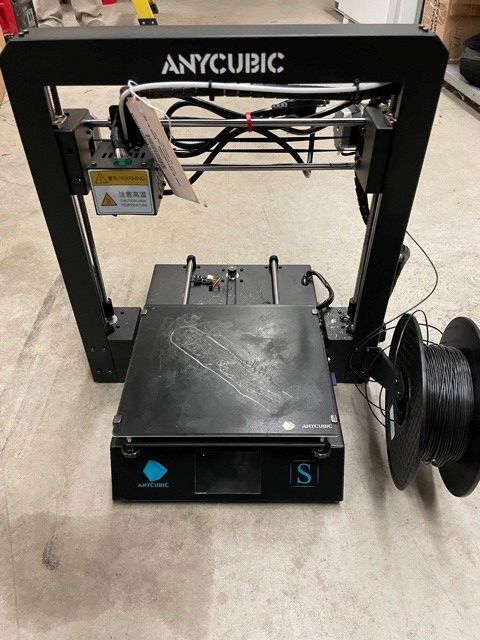A 16-year-old from the Virginia city of Hopewell shot himself in the leg by accident while working on a home-made semiautomatic pistol. The boy had apparently been assembling a gun by combining spare metal gun parts with plastic components he had 3D printed himself.
“His parents were generally shocked at the situation all around,” said Hopewell Police Lt. Cheyenne Casale. “They had no idea he even had any weapons in his room.”
The high school student’s name has not been identified because of his age. He did not suffer any life-threatening injuries and is already out of the hospital. When paramedics arrived, they discovered the incomplete handgun in addition to a $249 AnyCubic 3D printer, purchased for “hobby making”, according to the parents. There was a 3D printed plastic grip with partial trigger guard, as well as a 3D printed housing for the trigger mechanism featuring a full trigger guard and partial grip.

The teen’s Anycubic 3D printer. Image courtesy of Richmond Times Dispatch.
The boy attempted unsuccessfully to fit this component onto the metal barrel and slide of the spare gun parts. However, he was able to affix the 3D printed plastic handgun frame to the slide and barrel of an existing gun. Altogether, it “had all the necessary pieces for the trigger to work,” according to Casale. When he was working with this incomplete unit, loaded with a single round in the chamber, the gun fired and hit him in the leg. However, the pistol was not completed to the stage at which point it could hold a complete magazine and more rounds.
“The first one looks like it was attempt to make a handle, and then he stopped,” Casale said. “And the second one he did most of the handle, the trigger guard and the undermount where the slide is attached. But it didn’t have everything inside of it.”

The partially complete 3D printed gun. Image courtesy of Richmond Times Dispatch.
The police found no other ammunition in the boy’s room and no charges have been filed. However, the police are speaking to the Hopewell Commonwealth’s Attorney’s Office, and have spoken to state and federal law enforcement, such as the the Bureau of Alcohol, Tobacco, Firearms and Explosives.
“When we spoke to him briefly, he said he came across the [gun] parts, but he did not give us any more details than that,” Casale said. “And that’s where our investigation is now – where did he obtain these parts and how? They basically appeared to be replacement parts that he had put together for the top half of the gun.” The police are looking into who inspired the teen to attempt the project, if it was someone personally or “was this a kid who had a lot of time on his hands and was doing something he thought was cool he saw on YouTube,” Casale said.
3D printed weapons have been hyped ever since Cody Wilson’s Defense Distributed introduced the 3D printed Liberator pistol, with lawmakers globally attempting to regulate the technology in one way or another out of fear of 3D printed ghost guns. More level-headed media voices, however, have been more concerned with the safety of the user, given the potential for self-injury with 3D printed guns. Police from New South Wales, for instance, demonstrated that a Liberator-style 3D printed weapon could likely explode upon firing, causing a barrage of shrapnel from the plastic parts to injure those in the immediate vicinity.
Since those tests were performed in 2013, the field of 3D printed weapons has advanced to the point where it could become a concern, though still not to the level of readily acquirable weapons. This is because gun enthusiasts are able to modify existing firearms with 3D printed accessories that could render them more dangerous, as is the case of a 3D printed tool that can turn a semi-automatic assault rifle into a fully automatic one.
Therefore, like the rest of 3D printing, the hype is starting to approach the point where it matches reality. Though that may still be some ways off, there may be concerns that newer generations of printers capable of 3D printing engineering-grade plastic or metal on a desktop could result in more durable and sophisticated 3D printed weapons parts. We have also seen increasing incidents involving the seizure of 3D printed weapons, but so far no injuries outside of this self-inflicted one. Whether or not that requires some separate form of legislation related to the sharing or printing of “dangerous” CAD files, as has been pursued by lawmakers, is another story altogether.
Subscribe to Our Email Newsletter
Stay up-to-date on all the latest news from the 3D printing industry and receive information and offers from third party vendors.
You May Also Like
3D Printing Unpeeled: New Arkema Material for HP, Saddle and Macro MEMS
A new Arkema material for MJF is said to reduce costs per part by up to 25% and have an 85% reusability ratio. HP 3D HR PA 12 S has been...
3D Printing News Briefs, January 20, 2024: FDM, LPBF, Underwater 3D Printer, Racing, & More
We’re starting off with a process certification in today’s 3D Printing News Briefs, and then moving on to research about solute trapping, laser powder bed fusion, and then moving on...
3D Printing Webinar and Event Roundup: December 3, 2023
We’ve got plenty of events and webinars coming up for you this week! Quickparts is having a Manufacturing Roadshow, America Makes is holding a Member Town Hall, Stratafest makes two...
Formnext 2023 Day Three: Slam Dunk
I’m high—high on trade show. I’ve met numerous new faces and reconnected with old friends, creating an absolutely wonderful atmosphere. The excitement is palpable over several emerging developments. The high...































